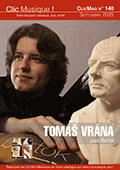 L’Ensemble Alternance, mené par le flûtiste Jean-Luc Menet propose trois pièces du claveciniste et compositeur français, élève de Gérard Grisey (1946-1998) et Franco Donatoni (1927-2000), toutes trois révisées récemment, car, selon Brice Pauset lui-même, « une œuvre représente toujours une solution temporaire à des questions de plus vaste portée ». Schlamm, partie du cycle informel Theorie der Tranen, se réfère à la Première Guerre Mondiale, dont les derniers survivants des tranchées voyaient leurs larmes (« tranen ») entraver les témoignages, comme la boue (« schlamm ») soudaient les bottes dans les fosses de la mort. Ecrite à l’origine pour flûte seule, le compositeur a ajouté, à une Eurydice où il relit le mythe du point de vue féminin, un conduit pour trio à cordes destiné à clore la « longue plainte chromatique » du soliste, « complexe circuit de liaisons polyphoniques » ramenant à l’étymologie même du titre. Un-Ruhe II, pour clavecin et récitant, succède à… Un-Ruhe I, pour voix, clavecin et orchestre spatialisé en trois groupes, donné au festival de Donaueschingen. Une succession à l’abîme particulièrement nourri, puisque le texte programmatique Un-Ruhe I constitue le livret de Un-Ruhe II. (Bernard Vincken)  “Eurydice“ is an isolated work and unlike the other works does not belong to a cycle. “Eurydice“ is related to an experience of thinking, one of my favorite concern. In this particular case and following to the ideological line rather closed to that of the philosopher Slavoj Zizek, it consists in revisiting a myth which accustomed to us to a single point of view, that of a victorious hero. Here I am interested in the subjectivity of the unfortunate and powerless heroine or more exactly an heroine condemned to unpower. Corollary the Orpheus's perverse psyche -particularly in the Monterverdi's version- reveals the narcissic profit of the hero ready to lose his love with the aim of her poetical glorification: or in more brutal words, Orpheus doesn't love Eurydice any more. He loves the vision of himself showing spectacularly his love. Here the flute takes hold of the subjectivity of the heroine when strings gradually absorb it in a kind of victorious march entirely focused on her self poetical celebration. Something which has probably to deal with the opera belongs to this work firstly because this type is actually and will be in the future my concern; then because there is a closed effect between the emergence of the opera and the development of the cogito by Descartes. "Un-Ruhe" (in german: upheaval) is a cycle of four works gathering three main ideas under different ways: chattering voice, harpischord and a spacialized and in a three groups divided orchestra. The complete cycle is a critic of democracy in its today normative form and refers easily to experiences of thinking: There are two litterary sources in the first piece: firstly Rosa Luxemburg, one of the most radical main figure of our past revolution history recognized by the global oligarchy as a past figure and for that reason has to be ignored; and secondly some graffitis, banners, anonymous tracts seen on Tahrir Place in Cairo: still alive traces of a recent revolution but acceptable because of the distance. "Theorie der Tränen" (Theory of tears) is the main title of a perfect informal cycle: works are gathering according to meetings and readings. Here I am interested in the interference of an uncontrolled subjective element, our own tears, but considered as a signal of realities seen as objective and significant: a social reality, a specific codification of interpersonal relations, the descrambling of specific affects. “Schlamm“ (mud in English) is related to the World War I. The last survivors of this massacre have discreetly passed away. To talk about the experience of the trenches was hard, almost impossible for them. At a moment tears prevent from speaking. But the witness will often have time enough to speak about another fluid : mud. This almost half-an-hour long piece aims to build an incomplete, heterogeneous and rough process with these two materials.
 |
